| |
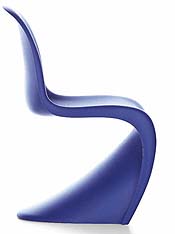
|
|
|
The
Panton chair
|
| |

|
|
|
"Verner
Panton" installation at the Vitra Design Museum
|
| |
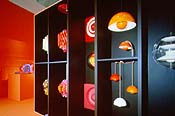
|
|
|
Panton's
"Luminaires" lighting fixtures
|
| |

|
|
|
Panton's
Flying Chairs (1963)
|
| |
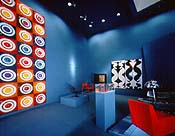
|
|
|
At
the Vitra Design Museum, Panton's illuminated ring lamp
wall panels and textile and enamel wall coverings.
|
| |
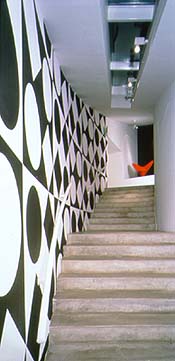
|
|
|
Panton's
Geometri IV pattern (1960) and his Heart Love Chair.
|
| |
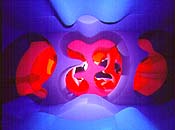
|
|
|
A
reproduction of Panton's 1970 Phantasy Landscape
|
| |
|
|
"Verner
Panton," Feb. 5-June 12, 2000, at the Vitra Design Museum, Weil
am Rhein, Germany.
Perhaps
no other designer captured the '60s zeitgeist better than Verner
Panton. In 1967, the Danish designer introduced the Panton chair,
a single piece of molded plastic that is nothing if not sexy.
This streamlined, slinky but sturdy bit of seating quickly became
a mainstay of glossy magazine spreads, often serving as a perch
for some naked pre-Raphaelite beauty.
Panton's
brainchild quickly touched off a flood of plastic mass-market
imitations. Today it counts among the few true icons of '60s
furniture.
It's
natural, then, that the chair holds pride of place in the Vitra
Design Museum's current Panton retrospective. With mockups and
market iterations arranged on three tiers of a towering display
case, the chair is traced from prototype to recent re-editions.
But
the late Panton's ambitions extended far beyond chairs. Trained
as an architect, he preferred to create integrated environments.
Few things held such horror, Panton once said, as striding into
a room to find a sofa, two chairs and a coffee table. Fighting
that traditional grouping, he designed furniture such as the
Living Tower, a massive foam rectangle within which five
people sat in a horizontal stack, each facing the knees of the
next person higher.
Panton
also used foam extensively in creating interior landscapes swirling
with curved shapes, most offering little indication of which
body part was meant to rest against them. Often these pieces
were designed as modules, meant to be rearranged as the situation
demanded. In short, Panton aimed to short-circuit the scripts
of social interaction by flooding people with new sensations.
From
that standpoint, the highlight of the exposition is a recreation
of Panton's Phantasy Landscape installation from the
1970 Visiona 2 design show in Cologne. Doffing their shoes,
visitors can enter the space, an experience akin to walking
down a corrugated culvert while tripping on peyote. Sponsored
by the Bayer chemical company as a vehicle for displaying its
new fabrics, Panton's room had 13 parallel sections, each roughly
a foot wide, spaced between two large porthole doors at either
end of the room.
Colored
in deep pinks, blues, oranges and reds, the sections vary in
form, curving this way and that to create sitting spaces, shoulder-height
outcroppings to lean on, and low, level areas fit for a long
nap. The room seems a realm of infinite possibility. As one
sober Swedish art magazine recently noted, "It would be possible
to try all kinds of [sexual] positions…thanks to the furniture's
organic and unexpected form." (The critic went on to lament
the difficulty of cleaning the woolen fabrics covering Panton's
pieces.)
There
is that adult-funhouse quality in much of Panton's work. Given
the Scandinavian reputation for graceful but dispassionate design,
Panton might seem an odd purveyor for such psychedelic love-fest
settings. But from early in his career he rebelled against the
dominant Danish design esthetic that revolves around smoothed
beech and great craftsmanship. In the tradition of American
designers such as Harry Bertoia, Eero Saarinen and the Eameses,
he turned to man-made materials such as chrome, foam and polyurethane.
Still,
Panton's work is not devoid of Nordic influence. The elements
making up his over-the-top designs tend toward a sort of spare
elegance. His 1959-60 series of foam-and-cotton "cone chairs,"
for example, all derived from a simple concept -- a cone-shaped
base with a curved back and round, slightly raised seat cushion.
It takes close examination by a visitor to spot the slight twists
he put on each one to create a whole line.
Likewise,
in the late '70s and '80s textile-design work on display --
executed in cretonne and velvet for maximum color saturation
-- Panton often started with a simple shape, such as a diamond
or circle, and a few colors, then toyed with their permutations
until the pattern clicked.
The
Vitra Design Museum is a dramatic setting for this show. Though
it is a bastion of furniture design and Frank Gehry's first
European museum, the building's planes of smoothed white concrete
join together at seemingly haphazard angles that foreshadow
Gehry's even more abstract Guggenheim Museum Bilbao.
True,
the building has a sense of fun, but that fun is of a more intellectual
genus than Panton's rich shades, trick lighting and sensuous
undulations. Gehry's work twists and turns, forcing the mind
to follow hard in order to grasp it, while Panton's flies at
you with its dazzling multiples and color. Panton might well
have hated the white walls that serve as Gehry's primary material,
but the museum's irregular spaces undoubtedly reinforce the
surreal nature of the show.
What
is one to make of such designs today, 30 years after the wilting
of Flower Power and free love? On the one hand, today's '70s
retro wave makes Panton's work seem ever more relevant; Panton's
work has been reissued by Habitat, Innovation Randers of Denmark
and Vitra itself.
On
the other hand, this retro wave has been cloaked in deep irony,
a sentiment completely absent from Panton's creations. With
hindsight on the decades of greed that followed, it's easy to
mock his work's exuberance and idealism. But it's just as easy
to envy it.
After
closing in Weil am Rhein, "Verner Panton" is scheduled to appear
at the Vitra Design Museum in Berlin, July 1-Oct. 7, 2000.
MARC
SPIEGLER covers culture from Zurich.
|

